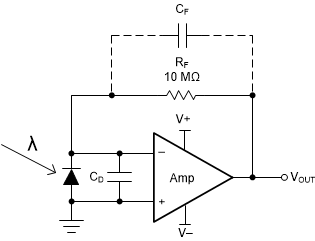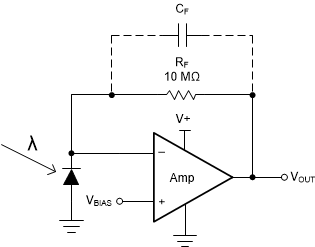ZHCSLZ5D October 2020 – December 2023 OPA3S328
PRODUCTION DATA
- 1
- 1 特性
- 2 应用
- 3 说明
- 4 Pin Configuration and Functions
- 5 Specifications
- 6 Parameter Measurement Information
- 7 Detailed Description
- 8 Application and Implementation
- 9 Device and Documentation Support
- 10Revision History
- 11Mechanical, Packaging, and Orderable Information
封装选项
机械数据 (封装 | 引脚)
散热焊盘机械数据 (封装 | 引脚)
- RGR|20
订购信息
8.1.3 Transimpedance Amplifier
Wide gain bandwidth, low-input bias current, low input voltage, and current noise make the OPA3S328 an excellent wideband photodiode transimpedance amplifier. Low-voltage noise is important because photodiode capacitance causes the effective noise gain of the circuit to increase at high frequency.
Figure 8-3 shows the key elements to a transimpedance design, which are:
- expected diode capacitance (CD); include the parasitic input common-mode voltage and differential-mode input capacitance
- desired transimpedance gain (RF)
- gain-bandwidth (GBW) for the OPA3S328 (40 MHz)
With these three variables set, the feedback capacitor value (CF) can be set to control the frequency response. CF includes the stray capacitance of RF, which is 0.2 pF for a typical surface-mount resistor.

For optimized frequency response, set the feedback pole as follows:

Equation 2 calculates the bandwidth.

For single-supply applications, the +IN input can be biased with a positive dc voltage to allow the output to reach true zero when the photodiode is not exposed to any light, and respond without the added delay that results from coming out of the negative rail. Figure 8-4 shows this configuration. This bias voltage also appears across the photodiode, providing a reverse bias for faster operation.

For more information, see the Compensate Transimpedance Amplifiers Intuitively and Build a Programmable Gain Transimpedance Amplifier Using the OPA3S328 application reports.